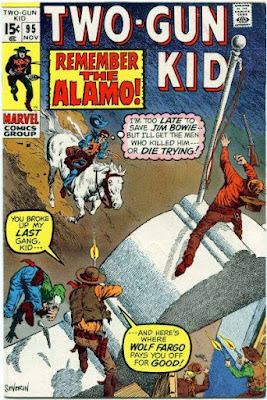Comics in Film: The Harder They Come (1972). Top Guns of the West: Super DC Giant #14, 1970.
Reggae star Jimmy Cliff reads a comic about gunfighters in this movie about a wannabe reggae star who finally has a big hit on the radio and the sales charts when he becomes a gunfighting marijuana dealer. This comic is a reprint collection of classic western stories illustrated by well-known superhero artists like Gil Kane, Carmine Infantino, and Joe Kubert (who drew the cover). Also seen in the film, in a scene where Cliff's jealous preacher boss looks through the car, is another 1970 comic book, Two Gun Kid #95, featuring stories by the Holy Trinity of Marvel Comics westerns, John Severin, Dick Ayers, and Jack Kirby. Cliff's character later become something of a "two gun kid" himself when he embarks on his crime spree, killing a bunch of cops with a pair of pistols and then brazenly posing for a set of glamour shots in a photo studio brandishing the same guns like a comic book cowboy. These imported U.S. comics were part of the cultural mileu that ska and reggae emerged out of, along with crime movies and U.S. top 40 pop and jazz. The desperate life of serial unemployment and low-level drug dealing the film documents had a fantasy flipside in the music that could just as easily reference "James Bond" and "Al Capone" as well as romance or Rastafarianism.




